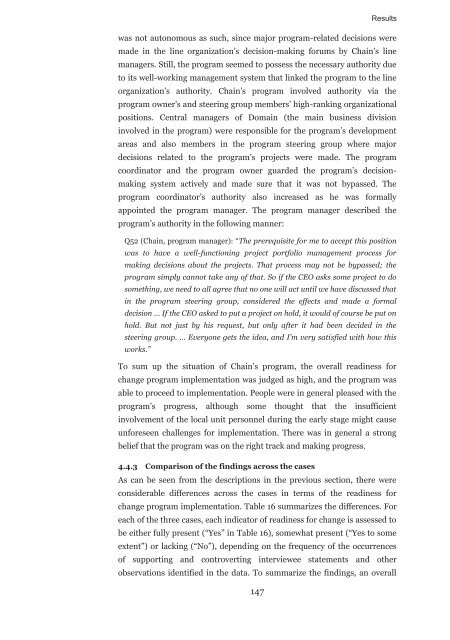Boundary activities and readiness for ... - Projekti-Instituutti
Boundary activities and readiness for ... - Projekti-Instituutti
Boundary activities and readiness for ... - Projekti-Instituutti
You also want an ePaper? Increase the reach of your titles
YUMPU automatically turns print PDFs into web optimized ePapers that Google loves.
Results<br />
was not autonomous as such, since major program-related decisions were<br />
made in the line organization’s decision-making <strong>for</strong>ums by Chain’s line<br />
managers. Still, the program seemed to possess the necessary authority due<br />
to its well-working management system that linked the program to the line<br />
organization’s authority. Chain’s program involved authority via the<br />
program owner’s <strong>and</strong> steering group members’ high-ranking organizational<br />
positions. Central managers of Domain (the main business division<br />
involved in the program) were responsible <strong>for</strong> the program’s development<br />
areas <strong>and</strong> also members in the program steering group where major<br />
decisions related to the program’s projects were made. The program<br />
coordinator <strong>and</strong> the program owner guarded the program’s decisionmaking<br />
system actively <strong>and</strong> made sure that it was not bypassed. The<br />
program coordinator’s authority also increased as he was <strong>for</strong>mally<br />
appointed the program manager. The program manager described the<br />
program’s authority in the following manner:<br />
Q52 (Chain, program manager): “The prerequisite <strong>for</strong> me to accept this position<br />
was to have a well-functioning project portfolio management process <strong>for</strong><br />
making decisions about the projects. That process may not be bypassed; the<br />
program simply cannot take any of that. So if the CEO asks some project to do<br />
something, we need to all agree that no one will act until we have discussed that<br />
in the program steering group, considered the effects <strong>and</strong> made a <strong>for</strong>mal<br />
decision … If the CEO asked to put a project on hold, it would of course be put on<br />
hold. But not just by his request, but only after it had been decided in the<br />
steering group. … Everyone gets the idea, <strong>and</strong> I’m very satisfied with how this<br />
works.”<br />
To sum up the situation of Chain’s program, the overall <strong>readiness</strong> <strong>for</strong><br />
change program implementation was judged as high, <strong>and</strong> the program was<br />
able to proceed to implementation. People were in general pleased with the<br />
program’s progress, although some thought that the insufficient<br />
involvement of the local unit personnel during the early stage might cause<br />
un<strong>for</strong>eseen challenges <strong>for</strong> implementation. There was in general a strong<br />
belief that the program was on the right track <strong>and</strong> making progress.<br />
4.4.3 Comparison of the findings across the cases<br />
As can be seen from the descriptions in the previous section, there were<br />
considerable differences across the cases in terms of the <strong>readiness</strong> <strong>for</strong><br />
change program implementation. Table 16 summarizes the differences. For<br />
each of the three cases, each indicator of <strong>readiness</strong> <strong>for</strong> change is assessed to<br />
be either fully present (“Yes” in Table 16), somewhat present (“Yes to some<br />
extent”) or lacking (“No”), depending on the frequency of the occurrences<br />
of supporting <strong>and</strong> controverting interviewee statements <strong>and</strong> other<br />
observations identified in the data. To summarize the findings, an overall<br />
147









